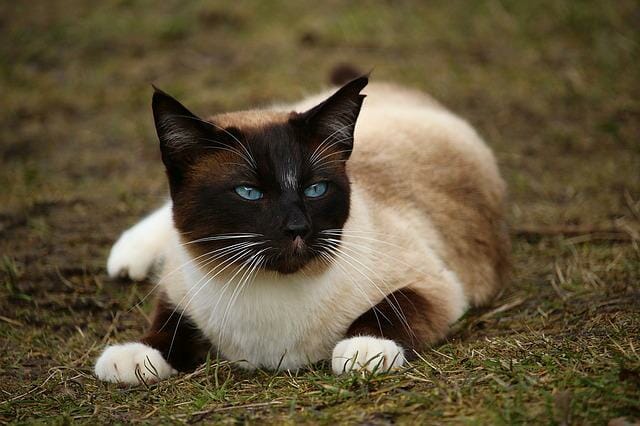Siamese Cat vs. Burmese Cat: Similarities and Differences of Siamese Cat and Burmese Cat
Siamese and Burmese cats have distinct differences in appearance and temperament. Siamese cats are slender and have a distinct colorpoint pattern, meaning their face, ears, tail, and legs are darker than their body. They have sleek, short hair and bright blue eyes, while Burmese cats have a more muscular build, come in a wider range of colors, and have rounder faces and gold or yellow eyes.


Table of Contents
Similarities of Siamese Cat and Burmese Cat
Affectionate
Siamese cats are affectionate and enjoy being close to their humans. They are often described as “lap cats” because they will cuddle up and sleep on their owner’s lap. They are also very vocal and often communicate with their owners through meowing and other sounds, which can express their affection.
Burmese cats are also affectionate and love to be around people. They are often described as “people cats” because they are very social and seek attention and affection from their owners, and are known to follow their owners around the house and may even greet them at the door when they come home.
Playful
Siamese cats are playful, and they have a lot of energy. They love to play games, such as fetch and often engage in playtime independently. They are also known for their curiosity and may explore their environment, including climbing furniture and playing with toys.
Burmese cats are also playful and enjoy interactive play with their owners. They are known to be very social and may enjoy playing games such as hide and seek with their owners. They also enjoy playing with toys, particularly interactive ones that require mental stimulation, such as puzzle feeders or dispensing treats.
Intelligent
Siamese cats are intelligent and known for their problem-solving abilities. They can be taught to do tricks, such as playing fetch, and they may even learn to open doors or drawers to access their food or toys. They are also very observant and often study their environment carefully, learning and memorizing routines and habits.
Burmese cats are also intelligent and are known for their ability to learn quickly. They can be trained to do tricks and respond to commands, and they may even be able to recognize their owner’s voice and come when called. They are also very curious and often explore their environment to learn more about the world around them.
Social
Siamese cats are social and affectionate with their owners, enjoy being close to their humans, and may follow them around the house or sleep beside them in bed. They are also known to be vocal and will often communicate with their owners through meowing or other sounds.
Burmese cats are also social and enjoy spending time with their owners. They are known for their friendly and outgoing personalities and often seek attention and affection from their humans. They also get along well with other cats and may enjoy playing and socializing.
Short Hair
Both Siamese and Burmese cats have short hair coats, which make them low maintenance in terms of grooming needs.
The Siamese cat has a short, sleek coat that is easy to maintain and has fine hair that does not shed excessively and requires minimal grooming, usually just a weekly brushing to remove loose hair and keep its coat shiny.
Similarly, the Burmese cat also has a short, close-lying coat that is easy to maintain. They have a silky texture to their fur and require minimal grooming, usually just a weekly brushing to remove loose hair and keep their coat healthy.
Differences between Siamese Cat and Burmese Cat


Physical Characteristics
Siamese cats are known for their long, slender bodies, wedge-shaped heads, and bright blue eyes. Their coat color is typically light, with darker “points” on the face, ears, tail, and legs. On the other hand, Burmese cats have rounder, muscular bodies, rounded heads, and large, expressive eyes and come in various solid colors, including brown, blue, chocolate, and lilac.
Personality
While both breeds are known for being affectionate and playful, they have slightly different personalities. Siamese cats are known for their vocal and talkative nature and can demand attention. They are also known to be intelligent and curious, which can make them active and sometimes naughty. Burmese cats are friendly, outgoing, and social but generally quieter than Siamese cats, and are also known for being adaptable and can get along well with children and other pets.
Health
Both Siamese and Burmese cats are generally healthy breeds, but they are prone to certain health conditions. For example, siamese cats can be prone to respiratory issues, such as asthma, and may also be susceptible to dental problems. On the other hand, Burmese cats may be prone to developing obesity and diabetes, as well as craniofacial defects.
Health Risks of Siamese Cat Burmese Cat
Dental Problems
Siamese and Burmese cats are prone to dental problems like periodontal disease and tooth decay. Dental problems can cause discomfort, pain, and bad breath, and if left untreated, they can lead to more serious health issues such as infections and tooth loss.
One of the main causes of dental problems in cats is the buildup of plaque and tartar on their teeth. Over time, this can lead to gum inflammation and infection, which can eventually cause tooth decay and loss.
Establishing a regular dental care routine is important to help prevent dental problems in your Siamese or Burmese cat. This should include daily teeth brushing using a cat-friendly toothpaste and toothbrush. In addition, providing dental chews or toys that help remove plaque and tartar from their teeth can also be beneficial.
Regular dental check-ups with a veterinarian are also important to monitor your cat’s dental health and catch any issues early on. For example, if your cat does develop dental problems, treatment options may include professional teeth cleaning, antibiotics to treat infections, or in severe cases, tooth extraction.
Respiratory Issues
Siamese cats, in particular, are known to be susceptible to respiratory issues such as asthma and bronchitis. These conditions can cause coughing, wheezing, difficulty breathing, and other symptoms that can be distressing for both the cat and its owner.
The exact cause of respiratory issues in Siamese cats is not fully understood, but it is believed to be a combination of genetic and environmental factors. Some experts believe Siamese cats may have a genetic predisposition to respiratory issues. In contrast, others believe that environmental factors such as exposure to tobacco smoke or household chemicals may play a role.
Treatment for respiratory issues in Siamese cats may involve medication such as bronchodilators or corticosteroids to help manage symptoms and reduce inflammation in the airways. Environmental changes such as reducing exposure to triggers like smoke or dust may also be recommended in some cases.
Preventative measures can also be taken to help reduce the risk of respiratory issues in Siamese cats. This may include keeping their living space clean and free of dust and other irritants, avoiding exposure to tobacco smoke, and providing good-quality air filtration systems.
Obesity
Burmese cats may be prone to obesity if they are overfed or do not get enough exercise. Obesity can lead to various health problems, including diabetes, joint problems, and heart disease.
To help prevent obesity in your Burmese cat, it is important to monitor their food intake and provide regular exercise. Feeding your cat a balanced, high-quality diet in appropriate portions is essential to maintaining a healthy weight. Avoid feeding your cat too many treats or table scraps, which can contribute to excessive calorie intake.
In addition to managing your cat’s diet, regular exercise is important to help prevent obesity. Encourage your cat to play and engage in physical activity, such as chasing toys, climbing cat trees, or even walking on a leash.
Craniofacial Defects


Due to their breeding history, siamese and Burmese cats may be prone to craniofacial defects. Craniofacial defects can include malformations of the skull, jaw, and facial structures, leading to various health problems such as difficulty eating, breathing, and even vision problems.
Some common craniofacial defects in Siamese and Burmese cats include a shortened upper jaw and a flat face. These defects can cause dental problems, difficulty eating, and respiratory issues.
While these defects may be more common in purebred Siamese and Burmese cats, they can also occur in mixed-breed cats with Siamese or Burmese ancestry.
If you suspect your Siamese or Burmese cat may have a craniofacial defect, it is important to take them to the veterinarian for an evaluation. Treatment options may depend on the severity and type of defect, including surgery, dental care, or other interventions to manage symptoms and improve quality of life.
Amyloidosis
Amyloidosis is a condition that can affect both Siamese and Burmese cats. According to Mayo Clinic, it is a condition that occurs when a protein called amyloid builds up in the body’s tissues and organs, leading to damage and dysfunction.
In Siamese cats, amyloidosis is most commonly seen in the liver, while in Burmese cats, it is more commonly seen in the kidneys. Symptoms of amyloidosis can vary depending on which organs are affected but may include weight loss, loss of appetite, vomiting, diarrhea, and jaundice.
The exact cause of amyloidosis in cats is not fully understood, but it is believed to be a combination of genetic and environmental factors. For example, genetic factors may make certain breeds, including Siamese and Burmese cats, more susceptible to developing amyloidosis.
Unfortunately, there is no cure for amyloidosis, and treatment options are limited. Management of symptoms may involve supportive care, such as intravenous fluids and medications to manage nausea and other symptoms. In severe cases, organ failure may occur, which can be life-threatening.
